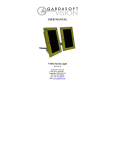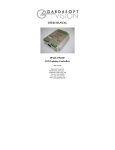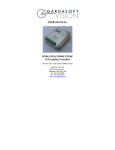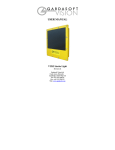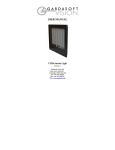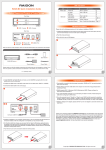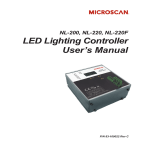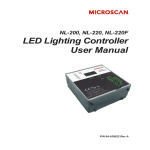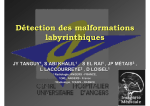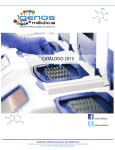Download USER MANUAL
Transcript
CC320 Trigger Timing Controller USER MANUAL Revision 07 Gardasoft Vision Ltd Castle Acres, Elsworth Cambridge, CB23 4JQ. UK Tel: +44 1954 200343 Fax: +44 1954 204343 Web: www.gardasoft.com 1 DISCLAIMER .................................................................................................................... 4 2 SAFETY .............................................................................................................................. 4 3 GETTING STARTED ........................................................................................................ 5 4 MECHANICAL FIXING ................................................................................................... 6 5 CONNECTIONS................................................................................................................. 7 5.1 GENERAL....................................................................................................................... 7 5.2 POWER SUPPLY ............................................................................................................. 7 5.3 DIGITAL INPUTS ............................................................................................................ 7 5.4 DIGITAL OUTPUTS ......................................................................................................... 8 6 OPERATION ...................................................................................................................... 9 6.1 6.2 6.3 6.4 6.5 7 INPUT MODES ................................................................................................................ 9 OUTPUT MODES .......................................................................................................... 10 EXAMPLES ................................................................................................................... 13 COLD BOOT ................................................................................................................. 19 CONFIGURATION FORM ............................................................................................... 20 KEYPAD CONFIGURATION ........................................................................................ 21 7.1 7.2 7.3 STARTUP ..................................................................................................................... 21 COLD START................................................................................................................ 21 CONFIGURATION ......................................................................................................... 21 8 ETHERNET SETUP......................................................................................................... 26 8.1 CONNECTION ............................................................................................................... 26 8.2 IP ADDRESS ................................................................................................................. 26 9 WEBPAGE CONFIGURATION..................................................................................... 30 9.1 MAIN PAGE ................................................................................................................. 30 9.2 CHANNEL CONFIGURATION PAGES.............................................................................. 30 10 UDP AND TCP/IP CONFIGURATION ......................................................................... 31 10.1 COMMUNICATION .................................................................................................... 31 10.2 COMMAND STRUCTURE ........................................................................................... 31 10.3 COMMANDS ............................................................................................................. 32 10.4 COMMAND SUMMARY ............................................................................................. 36 A. TIMING............................................................................................................................. 37 B. ERROR CODES ............................................................................................................... 38 1 Disclaimer Except as prohibited by law: All hardware, software and documentation is provided on an “as is” basis. It is essential that the user ensures that the operation of the product is suitable for their application. The user must ensure that incorrect functioning of this equipment cannot cause any dangerous situation or significant financial loss to occur. Gardasoft Vision Ltd and Gardasoft Products Ltd will not accept any liability for consequential loss of any kind. All trademarks acknowledged. Hardware, software and documentation are Copyright 2007 Gardasoft Products Ltd. Hardware manufactured by Gardasoft Vision Ltd under license. 2 2.1.1 Safety General Please read this before using the CC320 family of products. If in doubt, contact your distributor or Gardasoft Vision. The CC320 must not be used in an application where its failure could cause a danger to personal health or damage to other equipment. If the equipment is used in a manner not specified by the manufacturer, the protection provided by the equipment may be impaired. 2.1.2 Electrical The user must ensure that the potential difference between any combination of applied signals does not exceed the supply voltage. WARNING: Higher voltages may cause a danger to personal health. The CC320 does not have complete tracking isolation of inputs and outputs. Transients caused by inductive loads must be suppressed external to the CC320. 3 Getting Started Read the sections on Safety and Operation and check the CC320 fulfils your requirements. Mount the CC320 as described in “Mechanical Fixing” using a DIN rail or the mounting holes. Connect the CC320 as in the section on Connections. When the CC320 powers up it should show two alternating lines on the display to indicate that it is operating properly. Three indicator LEDs on the outputs should be pulsing in sequence every second. Check that inputs and outputs are working correctly as described in Troubleshooting. If required, connect Ethernet to the CC320 and set it up according to the Ethernet section. Read the section on “Operation.” Use the keypad, a web browser or the CC320 demo program (available from www.gardasoft.com) to configure the unit. Visit www.gardasoft.com for Application Notes giving additional information on the use of the CC320. Throughout this manual, references to the CC320 refer to all variants in the CC320 range unless otherwise stated. The symbol “s” is used to indicate seconds, “ms” for milliseconds and “us” for microseconds. 4 Mechanical Fixing The CC320 does not have an IP rating and should be mounted so that moisture and dirt cannot enter the unit. The operating temperature range is 5oc to 60oc. The CC320 can be mounted onto a panel using the threaded holes in the base, see diagram below. The PP703 kit is available for mounting the CC320 on a DIN rail. The top drawing shows the optional DIN rail fitted. Dimensions are in millimetres. The CC320 enclosure is a fire enclosure as long as the following conditions are met: • The Ethernet connector must not be facing downwards • The mounting holes on the underside must be covered or have a screw fitted. 5 5.1 Connections General All connections except Ethernet are available on screw terminals. 5.2 Power Supply The power supply must be 12VDC to 24VDC regulated. The maximum current required is 100mA. The maximum heat dissipation is 2.4W. 5.3 Digital Inputs The state of each input is shown on an LED next to the connector. The inputs have a common negative connection, in two groups of four. Opto-Coupled Input Details Operating Conditions Connector Function POWER + Power supply 12V to 24V POWER - Power supply 0V IP1 Input 1 positive IP2 Input 2 positive IP3 Input 3 positive IP4 Input 4 positive COM1 Common negative for inputs 1, 2, 3, 4 5V ∗ VIP ∗ 24V Logic 1 IP5 Input 5 positive VIP ∗ 2V Logic 0 IP6 Input 6 positive VF 1.5V typ IP7 Input 7 positive IIN=1.8mA @ VIP=5V IP8 Input 8 positive IIN=11.3mA @ VIP=24V COM1 Common negative for inputs 5, 6, 7, 8 5.4 Digital Outputs The state of each output is shown by an LED indicator next to the connector. The operational details are shown in the table below: Open Drain Output Details The voltage across the output must not be greater than 24V and the output can only sink up to 50mA. If the output is shorted to a voltage higher than 5V then the output may be damaged. Do not draw more than 50mA from the +VE connections as this will affect the internal operation of the controller. Connector Function GND1 Common 0V for outputs 1, 2, 3, 4 OP1 Output 1 open drain OP2 Output 2 open drain OP3 Output 3 open drain OP4 Output 4 open drain +VE Low power regulated output. Maximum source current 50mA. GND2 Common 0V for outputs 5, 6, 7, 8 OP5 Output 5 open drain OP6 Output 6 open drain OP7 Output 7 open drain OP8 Output 8 open drain +VE Low power regulated output. Maximum source current 50mA. Note that the +ve signals are low power supply outputs. These are just to be used for low current pull ups. 5.4.1 Ethernet Connector The RJ45 Ethernet connector requires a straight through cable to connect into a network switch, hub or router. It runs at 10Mbits per second. 6 Operation The CC320 Trigger Timing Controller has eight digital inputs and eight digital outputs. All outputs operate independently and are configured separately. Configuration is very flexible to provide solutions for a wide variety of timing problems. The configuration can be saved in non-volatile memory so that the CC320 will resume operation after a power cycle. The state of each input and output is shown on an LED next to the connector. Pulses are stretched – a 10us pulse will be shown as a 100ms pulse on the LED, so that it is visible to the user. 6.1 Input Modes All inputs are general purpose trigger inputs except for IP1 and IP2, which can be used for an encoder or as general inputs. 6.1.1 Encoder Operation The CC320 supports two types of encoder. Mode Connections Operation Max frequency EN 1 - one wire encoder IP1 is QEA Simple encoder provides position information. All movement is assumed to be forward. 700KHz EN 2 – two wire encoder IP1 is QEA Quadrature encoder provides position and direction information. 200KHz IP2 is QEB For 2 wire encoders the CC320 will handle reversed movement correctly. When the belt is in a reversed position: • the letter “b” will be displayed on the front panel • triggers for PEt and PEE modes (see below) will be ignored • output pulses in PtE, Pet and PEE modes will not be duplicated 6.1.2 Free Running Trigger An internal input (IP0) can be used as a periodic trigger. The following parameter can be set. Parameter Period Use The period (inverse of the frequency) of the simulated trigger. 0 disables the free running timer. For example a period of 20ms could be set, which would result in a 50Hz trigger. This can be used to trigger pulses on any of the outputs. 6.2 Output Modes Each output operates independently. By combining which outputs are triggered by which inputs and which mode each output is in, it is possible to configure complex sequences of operation. Several outputs can be triggered by one input to give synchronous operation, or from separate inputs to give asynchronous operation of different functions. For each output, the following parameters can be set. Parameter Use Mode Specifies how the output operates. Input Specifies which input is used for triggering. An output signal OP1 to OP8 can also be used as a trigger. This parameter can be: 0 for the free running timer 1 to 8 for IP1 to IP8 9 to 16 for OP1 to OP8 Gate Input Specifies an input which enables/disables the output. This is also used to specify the number of pulses in “burst” mode. This parameter can be: 0 for none 1 to 8 for IP1 to IP8 9 to 16 for OP1 to OP8 <number of pulses> for burst mode Pulse Delay Specifies the delay from trigger to pulse output. This can either be a time period or a number of encoder pulses, depending on the mode. Pulse Width Specifies the width of the pulse output. This can either be a time period or a number of encoder pulses, depending on the mode. Retrigger time The retrigger time is the minimum time from when an output is triggered to the next time. This can be used to debounce noisy inputs or when a product sensor fires more than once for one product. The retrigger time uses the same dimension (encoder pulses or time period) as the Pulse Delay. Flags Specifies other options. When pulsing, the Pulse Delay and Pulse Width parameters can either be fixed times or can be a number of encoder pulses. The following operating modes are available for each output. The Mode Number is used for Ethernet commands. The Mode Name is used when configuring using the keypad. Mode Mode Name Operation 0 OFF The output is set off. If the output is inverted (flag O is set) then the output will be logic 1, otherwise logic 0. 1 On The output is set high (on). If the output is inverted (flag O is set) then the output will be logic 0, otherwise logic 1. 2 Ptt Pulsed output triggered by a digital input. The delay and pulse width are set as fixed times. 3 PtE Pulsed output triggered by a digital input. The delay is a fixed time. The pulse width is a number of encoder pulses. 4 PEt Pulsed output triggered by a digital input. The delay is a number of encoder pulses. The pulse width is a fixed time. 5 PEE Pulsed output triggered by a digital input. The delay and pulse width are a number of encoder pulses. 6 Pd Pulse divider. Every <Pulse Delay> trigger pulses, the output is pulsed for <Pulse Width> time. 7 Enc Pulsed output triggered by encoder pulses. The output is pulsed for <Pulse Width> encoder pulses with the pulses separated by <Pulse Delay> encoder pulses. The Input and Gate Input parameters are not used. 8 bur Burst output. When triggered, <Gate Input> pulses are output. Each pulse is <Pulse Width> long and the time between the start of one pulse and the next is given by <Pulse Delay>. The maximum number of pulses that can be output is 250. 9 FrE Outputs a constant high frequency square wave. The frequency is configurable. Further details available from Gardasoft. 10 buF Buffer an input by making the output the same signal as the input. If there is gate input set, then the gate input signal enables the output – if the gate input is off then the output is off. Flag O inverts the output and Flag G inverts the gate input. The output can be delayed by a fixed time given by the <Pulse Delay> parameter. Note that any Gate Input is applied before the delay. The E flag can be set to indicate when the output changes state. 11 buE Same as buF mode, except the output signal can be delayed by a given number of encoder pulses. Each output also has the following flags which specify other options. For Ethernet commands, multiple flags can be set by adding the flag values together. Flag value 6.2.1 Flag Name Operation Operation when flag = 0 when flag = 1 1 I Trigger off leading edge of input. Trigger off trailing edge of input. 2 O Output is normally low, going high when pulsing. Output is inverted. It is normally high, going low when pulsing. 4 G If a gate input is specified, the input must be high to enable triggers. If a gate input is specified, the input must be low to enable triggers. 8 E No Ethernet message. Send message on Ethernet when triggered. 16 F Triggers are ignored until output pulse is complete. FIFO output mode. Multiple triggers are queued up. 32 R Resync mode disabled. Resync Mode enabled. 64 P Default to pulse in resync mode. Default to no pulse in resync mode. Burst Mode In burst mode, an output will pulse several times in response to a trigger. The periods are timed (not encoder counts). The following parameters are used: • Mode is 8 for burst mode • Gate Input specifies the number of pulses (1 to 250) • Pulse Width specifies the pulse width • Pulse Delay specifies the separation between the start of one pulse and the start of the next Pulse Delay must be longer than Pulse Width. 6.2.2 Ethernet Message Flag (E) When the CC320 is used to trigger a camera, the image processing can either be triggered by the acquisition of an image or by an Ethernet message sent from the CC320. When a trigger is received it is assigned a unique tag number (an incrementing number from 0 to 255). Using the GT Ethernet command and the Ethernet Message flag, the CC320 will send the tag number in a message to the host computer to say that a trigger has occurred. The message has the form: Evt<channel>,<tag> where <channel> is the channel number from 1 to 8 and <tag> is a number from 0 to 255. Multiple tag messages may be sent in one packet, separated by “;”. 6.2.3 Resync Flag (R) Reject gate operation usually needs to be synchronised to the original product trigger. However image processing can take a variable length of time to complete, so rejects based on when the processing result is available will not be accurately timed. The Resync flag allows pass/fail results to be re-synchronised to the original trigger. There are two types of reject gate: • A pulse is required to reject a product (set the P flag) • A pulse is required to stop a product being rejected (don’t set the P flag) The Resync Flag should be used with the Ethernet Message flag. The host computer will receive a tag number message, process the image and then send a pass/fail result (as an SN command) back to the CC320. The CC320 will match the message to the original trigger and time the pass/fail output pulse accurately. If an SN command is not received in time, then the product will be rejected, and an error code output. 6.2.4 FIFO Flag (F) The FIFO flag is used for systems where there can be more than one product between the trigger point and reject gate. This is usually used with the Resync flag, so that each product has its own pass/fail result. If the FIFO flag is not set, then an output cannot be re-triggered until the previous pulse has completed. Others triggers in this time will be ignored. If the FIFO flag is set, then multiple triggers are stored in the CC320 and a pulse is generated for each trigger at the correct time. 6.2.5 Pulse Flag (P) The Pulse flag is used to select whether a pulse is needed to reject or to accept a product when the Resync flag is set. When not set, a pulse is required to reject product. If a pass/fail message is not received in Resync mode, the CC320 will default to rejecting the product. 6.3 Examples 6.3.1 Sequenced Pulses A sensor detects product presence. There are two cameras which need to take an image after different delays. The leading edge of IP1 is used as the trigger. OP1 triggers the first camera after 100ms. OP2 triggers the second camera after 200ms. Both camera triggers are positive pulses. Flags Retrigger Time Pulse Width Pulse Delay Gate Input Input Mode Output 1 2 1 0 100ms 100us 0 0 2 2 1 0 200ms 100us 0 0 Both outputs are set into pulse mode. Two different delays give the timing difference between the two cameras. 6.3.2 Gated Pulses 1 100us 0 Flags 0ms Retrigger Time Gate Input Input 0 Pulse Width 2 Pulse Delay 1 Mode Output A camera needs to be triggered at 25Hz continuously, except when IP1 is high to indicate that the machine has stopped. The camera is triggered on OP1. G (4) Set free running trigger to 25Hz. OP1 will trigger continuously at 25Hz only when IP1 is low. Note that Flags = 4 to invert the sense of IP1. If Flags = 0, then OP1 will only trigger when IP1 is high. 6.3.3 Belt Position Triggering 5 4 0 2000 encoder counts 100us 1 5 4 0 4000 encoder counts 100us 1 Flags Retrigger Time Pulse Width Pulse Delay Gate Input Input Mode Output On a conveyor with an encoder, a sensor detects product presence. There are two cameras which need to take an image at fixed distances along the belt. The camera trigger pulses must be fixed width for exposure control. The trailing edge of IP4 is used as the trigger. OP1 triggers the first camera after 2000 encoder counts. OP2 triggers the second camera after 4000 encoder counts. Both camera triggers are negative pulses. 0 I, O (3) 0 I, O (3) Set input mode to 2-wire encoder. Both outputs are set into pulse mode. The pulse delay is a number of encoder pulses and the pulse width is a fixed time. The flags specify the trailing edge of the trigger signal and that the output pulse is active low. 6.3.4 Pulse Burst A sensor on IP1 detects product presence. Four images need to be taken from one camera using four different lights at 40ms intervals. OP1, OP2, OP3, OP4 are used to output triggers to turn on the four lights in sequence. OP5 is used to trigger the camera four times. 0 0 40ms 0 0 3 2 1 0 80ms 40ms 0 0 4 2 1 0 120ms 40ms 0 0 5 8 1 4 40ms 100us 0 0 Flags Pulse Width 40ms 40ms Retrigger Time Pulse Delay 0ms 0 Gate Input 0 1 Input 1 2 Mode 2 2 Output 1 OP1 to OP4 are pulsed for 40ms in sequence. As each one is pulsed, OP5 is also pulsed for a short time to trigger the camera (Gate Input = 4 specifies four pulses). 6.3.5 Simple FIFO Mode A sensor on IP1 detects product presence. After a delay OP1 triggers a camera. There may be several products between the sensor and the camera. The CC320 needs to store each of the triggers and then output a pulse after the correct delay. 6.3.6 2 1 0 10 seconds 100us 0 Flags Retrigger Time Pulse Width Pulse Delay Gate Input Input Mode Output 1 F (16) Resync Mode A sensor on IP1 detects product presence. After a delay OP1 triggers a camera. Image processing software processes the image (which can take a variable length of time) and then sends a pass/fail message to the CC320. The pass/fail is re-synchronised to the original product presence and the reject gate is opened if necessary. 1 2 1 0 200ms 100us 0 2 2 1 0 10 seconds 1 second 0 Flags Retrigger Time Pulse Width Pulse Delay Gate Input Input Mode Output The reject gate is on OP2 and pulses high to reject the product. Products take 10 seconds to travel from the sensor to the reject gate and take 1 second to move past the reject gate. E,R,P (104) 10 seconds after a trigger, OP2 is set to pulse for 1 second to reject a product. The camera trigger has the “Send trigger message” flag set. So that the product is detected, a message is send to the image processing software. The image processing software must use the GT command to receive these messages. The image processing has to send a pass/fail message before the reject gate is reached by the product. As well as “Resync mode” the “default to pulse” flag is set. This means that if the image processing software does not send a pass/fail message OP2 is pulsed anyway. In this example, three product triggers were received. The camera was triggered using OP1. An Ethernet message with tag number 10 was sent to the host computer when the first trigger was received, but for some reason a reply was not received, so the product was rejected for failsafe operation. After the second trigger a Tag 11 message was sent, with the reply “SN2,11,1” (OP2, tag 11, pass) so the reject pulse on OP2 was cancelled. After the third trigger a Tag 12 messages was sent, with the reply “SN2,12,0” (OP2, tag 12, fail) so the reject pulse on OP2 was not cancelled. 6.3.7 Resync and FIFO Mode This uses the same situation as the previous example, but products are 4 seconds apart, so that when a product is detected, there are already two others travelling towards the reject gate. Image processing software processes the image (which can take a variable length of time) and then sends a pass/fail message to the CC320. The pass/fail is re-synchronised to the original product presence and the reject gate is opened if necessary. 2 1 0 200ms 100us 0 2 2 1 0 10 seconds 1 second 0 Flags Retrigger Time Pulse Width Pulse Delay Gate Input Input Mode Output 6.4 1 E, F, R, P (120) Cold Boot A cold boot function is available to reset the CC320 to a known state. The unit can be cold booted as follows: • • • Press and hold the SEL and DOWN buttons when powering up the unit Sending an Ethernet command Pressing a button on an internal webpage When the unit is cold booted it is set to the following state: • • • • • • • • • • IP0 (free running trigger) is set up as a 1Hz internal trigger The unit is set up for no encoder input OP1 triggers from IP1, delay for 100ms then pulse for 100ms OP2 triggers from IP2, delay for 100ms then pulse for 100ms OP3 triggers from IP3, delay for 100ms then pulse for 100ms OP4 triggers from IP4, delay for 100ms then pulse for 100ms OP5 triggers from IP5, delay for 100ms then pulse for 100ms OP6 triggers from IP0, delay for 100ms then pulse for 100ms OP7 triggers from IP0, delay for 200ms then pulse for 100ms OP8 triggers from IP0, delay for 300ms then pulse for 100ms 6.5 Configuration Form 1 2 3 4 5 6 7 8 Free running timer period: Encoder mode: Tick when complete Flags Retrigger Time Pulse Width Pulse Delay Gate Input Input Mode Output Before configuring the CC320, work out all the values and fill in a copy of the form below. This form is available on the CC320 page at www.gardasoft.com. 7 Keypad Configuration The CC320 is set up using the push buttons and display on the front of the unit. The set up is non-volatile, so the CC320 will resume the same operation after a power cycle. 7.1 Startup On power up, the CC320 will display “8.8.8.” to test the display is working, then “CC”, “320”, followed by the version number, eg “001”, and then will be ready for operation. To show that the unit is operating normally, a moving pattern is drawn on the display. 7.2 Cold Start In the unlikely event that the non-volatile memory becomes corrupt the CC320 may not start up properly. In this case the memory can be cleared by powering up the CC320 while holding down the SELECT and DOWN buttons. The CC320 will display “COL” for about 2 seconds while the memory is cleared. 7.3 --- SEL OP I SEL UP/DOWN OP2 SEL OP8 SEL Set up an output channel Configuration To configure the controller from the keypad, press and hold SEL for 1 second. “OP1” will be displayed. The overall structure of keypad configuration is given to the right. UP/DOWN EnC SEL Set up encoder mode SEL Set up Ethernet SEL Set up free running timer UP/DOWN The UP and DOWN buttons are used to change the selection and to change numeric values. The SEL button is used to confirm a selection and move to the next item. When configuration is complete, “End” is displayed. See the section on the Ethernet for setting up IP addresses. 7.3.1 EtH UP/DOWN FrE Setting Numeric Values When the CC320 displays numeric values for the user to change, the right hand digit will be flashing to indicate that the Up and Down buttons can be used to change the value. To be able to set timing and encoder count values (for pulse delay, pulse width and retrigger time) a scheme is used where the exponent (power of ten) of the value is set. For timings, the exponent values are as follows: Exponent value Multiplier Number format Range of values E0 1 999. Values are displayed in seconds from 1s to 999s in steps of 1s. E-1 0.1 99.9 Values are displayed in seconds from 0.1s to 99.9s in steps of 0.1s. E-2 0.01 9.99 Values are displayed in seconds from 0.01s to 9.99s in steps of 0.01s. E-3 0.001 999. Values are displayed milliseconds from 1ms 999ms in steps of 1ms. E-4 0.0001 99.9 Values are displayed in milliseconds from 0.1ms to 99.9ms in steps of 0.1ms. The flow diagram for entering timings on the keypad is given below. E0 SEL 999. SEL SEL 99.9 SEL SEL 9.99 SEL SEL 999. SEL 99.9 SEL UP/DOWN E-1 Enter the time in seconds UP/DOWN E-2 UP/DOWN E-3 Enter the time in milliseconds UP/DOWN E-4 SEL in to For encoder counts, the exponent values are as follows: Exponent value Multiplier Number format Range of values E0 1 999. Values are from 1 count to 999 counts in steps of 1. E1 10 9.99 Values are displayed in K from 0.01K counts to 9.99K counts in steps of 0.01K. E2 100 99.9 Values are displayed in K (thousands) from 0.1K counts to 99.9K counts in steps of 0.1K. E3 1000 999. Values are displayed in K from 1K counts to 999K counts in steps of 1K. E4 10000 9.99 Values are displayed in M (millions) from 0.01M counts to 9.99M counts in steps of 0.01M. E5 100000 99.9 Values are displayed in M from 0.1M counts to 99.9M counts in steps of 0.1M. E6 1000000 999. Values are displayed in M from 1M counts to 999M counts in steps of 1M. The flow diagram for entering encoder counts on the keypad is given below. E0 SEL 999. SEL SEL 9.99 SEL SEL 99.9 SEL SEL 999. SEL SEL 9.99 SEL SEL 99.9 SEL SEL 999. SEL UP/DOWN E1 UP/DOWN E2 Enter encoder count in ones Enter encoder count in thousands UP/DOWN E3 UP/DOWN E4 UP/DOWN E5 UP/DOWN E6 Enter encoder count in millions 7.3.2 Setting Up Encoder Mode Set the encoder mode from the keypad as follows. Press and hold the SEL button until the display shows “OP1”. Use the UP and DOWN buttons to select “Enc” then press SEL. Select the encoder mode using UP and DOWN and press SEL. Enc SEL Press and hold SEL for 1 second. Then use UP/DOWN to select “Enc”, then press SEL 7.3.3 non UP/DOWN n1 SEL UP/DOWN n2 End Select encoder mode and then press SEL Setting Up The Free Running Timer Set the free running timer period from the keypad as follows. Press and hold the SEL button until the display shows “OP1”. Use the UP and DOWN buttons to select “FrE” then press SEL. Set the free running timer period. See section 7.3.1 for a description of how to set the time period. FrE SEL Press and hold SEL for 1 second. Then use UP/DOWN to select “FrE”, then press SEL 7.3.4 Set up free running timer period as in Section 7.3.1 End Setting Up An Output Channel The overall structure for setting up an output channel is given below. Configuration mode must be entered once for each output channel to be set up. The output mode names are given in Section 6. Depending on the selected mode, the user will be prompted to enter a time or a number of encoder pulses as appropriate for the pulse delay and pulse width. The flag names are given in Section 6. A minus (“-“) sign indicates that the flag is not set. So “F-I” indicates that the I flag is not set and “F I” indicates that it is set. OP2 SEL Off SEL Press and hold SEL for 1 second. Then use UP/DOWN to select from “OP1” to “OP8”, then press SEL Only for “bur” mode the Gate parameter is a number from 2 to 250 End 250 UP/DOWN On trg UP/DOWN gAt non UP/DOWN Ptt UP/DOWN IP0 SEL SEL PtE IP1 UP/DOWN SEL SEL IP8 UP/DOWN IP8 SEL dEL Set up pulse delay time or encoder count as in Section 7.3.1 PUL Set up pulse width time or encoder count as in Section 7.3.1 rEt Set up retrigger time or encoder count as in Section 7.3.1 Enc F-I F-O UP/DOWN UP/DOWN bur FI FO Fg F-F F-r F-P PEt UP/DOWN PEE UP/DOWN Pd IP1 UP/DOWN UP/DOWN FF SEL SEL UP/DOWN UP/DOWN Fr F-g SEL SEL UP/DOWN UP/DOWN FP F-E SEL UP/DOWN FE SEL End 8 Ethernet Setup You may need to ask your network administrator for advice about setting up the Ethernet connection. Ethernet set up is not affected by cold booting the CC320. 8.1 Connection The Ethernet link uses a 10 base-T connection on an RJ45 connector. The CC320 will usually be connected to a network switch (or hub or router). It is also possible to connect it direct into the network port on a PC by using a swapover cable. 8.2 IP Address The CC320 needs an IP address to communicate over Ethernet. There are two ways to get an IP address; either a fixed address configured in the unit or using DHCP. Most networks use a DHCP server. If there is a PC on the network, You may be able to find out whether a PC on the same network uses DCHP as follows: • Go to Control Panel • Select Network Connections • Right click on Local Area Connection. Select Properties • From the list, select Internet Protocol (TCP/IP), press Properties If “Obtain an IP address automatically” is set, then DHCP is probably used. However, there may be an alternative fixed IP address on the “Alternative Configuration” tab. You can find out what IP address is being used by a PC at any time by: • Go to Control Panel • Select Network Connections • Right click on Local Area Connection. Select Status • Select the Support tab. The IP address is displayed When using a fixed IP address, you must ensure that you use an IP address that is not being used by any other device on the network. It is usual to keep the first three numbers of the IP address the same as other devices and to change only the last number. For example, if you have a network consisting of a PC (IP address 192.168.1.35) and two CC320s, you might give them addresses 192.168.1.201 and 192.168.1.202. For DHCP mode, the CC320 acquires its IP address, subnet mask and gateway address from a DHCP server. Otherwise the CC320 has a fixed IP address, subnet mask and gateway address. 8.2.1 Setting DCHP or an IP Address from the Keypad Set DHCP mode from the keypad as follows. Press and hold the SEL button until the display shows “OP1”. Use the UP and DOWN buttons to select “ETH” then press SEL. The display will either show “FIP” for a fixed IP address or “dhC” for DHCP. Use the UP and DOWN buttons to select “dhC” and press SEL. For a fixed IP address, select “FIP” and press SEL. The user will be prompted to enter four bytes of the IP address, four bytes of the address submask and then four bytes of the gateway address. dhc SEL End SEL 255 Set DHCP mode UP/DOWN FIP SEL IP I SEL IP2 SEL 255 IP4 SEL 255 Sb2 SEL 255 Sb4 SEL 255 gt2 SEL 255 gt4 SEL 255 Set IP address SEL IP3 SEL 255 SEL SEL SbI SEL 255 SEL Set IP submask SEL Sb3 SEL 255 SEL SEL gtI SEL 255 SEL gt3 SEL 255 SEL Set gateway address SEL SEL End When an IP address has been assigned using DHCP, the address can be read from the keypad as follows. Press and hold the SEL button until the display shows “OP1”. Use the UP and DOWN buttons to select “ETH” then press SEL. Use the UP and DOWN buttons to select “rIP” and press SEL. Keep pressing SEL and read the four values of the IP address. The example below shows the IP address 192.168.1.71. dhc UP/DOWN FIP UP/DOWN Show IP address rIP SEL IP I SEL 192 SEL IP2 SEL 168 IP4 SEL 71 SEL IP3 8.2.2 SEL 1 SEL SEL End Setting DCHP or an IP Address from the Keypad The DCHP mode or a Fixed IP address can be configured from the Ethernet Demo application which can be downloaded from the CC320 page at www.gardasoft.com. Communication All the features below are implemented in a demonstration program available from www.gardasoft.com. 8.2.3 Automatic Sensing The CC320 will send out a message on three events: • On power up • When an IP address is received or renewed by DHCP • When an enquiry message is received On the first two events, the message is broadcast. On the third it is a reply to a single IP address. An enquiry message is a UDP packet from source port 30310, destination port 30311 with the message body “Gardasoft Search” (8-bit ASCII, 13 characters). The message output by the CC320 is a UDP packet from source port 30311, destination port 30310. It is formatted as: Gardasoft,CC320,000000,111111111111,22222222 (8-bit ASCII, 44 characters), where 000000 the serial number of the unit 111111111111 the MAC address in 6 HEX bytes 22222222 the IP address in 4 HEX bytes For example for CC320 serial number 12345, IP address 192.168.1.103, MAC address 00.0B.75.01.80.99 the packet will contain Gardasoft,CC320,012345,000B75018099,C0A80167 9 Webpage Configuration The CC320 has a small webserver inside, so that it can be configured from a standard web browser, such as Internet Explorer. The IP address of the CC320 must be known (see the section on “Ethernet Setup.” Open a web browser window and type the IP address (for example 192.168.1.71) of the CC320 into the URL box at the top. The main page of the CC320 webserver should be shown. 9.1 Main Page The main page shows general information about the CC320 and can be used to set up the Encoder mode and the Free Running Timer period. Press the Submit button to update the CC320 and save the changes to nonvolatile memory. Links are provided to the channel configuration pages. 9.2 Channel Configuration Pages There is one Channel Configuration Page for each output channel. All the parameters for each output channel can be set up. Press the Submit button to update the CC320 and save the changes to non-volatile memory. 10 10.1 UDP and TCP/IP Configuration Communication The CC320 can be configured via the Ethernet connection using UDP or TCP/IP. A demonstration program with source code can be downloaded from www.gardasoft.com. Communication consists of commands sent by the host (controlling PC). All output generated by the command is returned in reply UDP or TCP/IP packets. The last character sent is “>” (“greater than” symbol). Once this is received, the host knows that the command has been completed. It is recommended that the host waits for the “>” symbol before sending the next command. UDP communications are not guaranteed to arrive, so the host software must be able to cope with lost messages. Using the GT command, a host can request that a message is sent to it whenever an error occurs. Commands from a host should be sent to destination port 30313. Any port number can be used for the source port. Replies from the C320 will be sent to the source port. A TCP/IP connection will timeout and close if it is idle for more than 10 seconds. The host must send regular “heartbeat” commands (eg “VR”) to keep the link open. 10.2 Command Structure Several commands can be put into one command line by separating them by a semi-colon (“;”). A carriage return character should be sent to terminate the command line. The CC320 will send any replies to the commands and then send a ‘>’ character to indicate that the command line has been completed. Commands comprise a code of two letters followed by the parameters (if any) needed for the command. Spaces in the commands are ignored. Numeric parameters are separated by a comma (“,”). For a parameter which is a time period the default units are milliseconds. “s”, “ms” or “us” can be added to the end of the number to indicate seconds, milliseconds or microseconds. “K” can be used for 1000 encoder pulses and “M” for 1000000 encoder pulses. For example: Parameter Meaning 0.1 0.1 milliseconds 200us 200 microseconds 0.1s 0.1 seconds 100 100 encoder pulses 15.5K 15500 encoder pulses 14.5M 14500000 encoder pulses Encoder values can be up to 1,000,000,000. Time periods can be from 0.1ms to 100 seconds in steps of 0.1ms. Note that parameters are in “USA/UK” format so that one half is written “0.5” not “0,5” The command codes and their meaning are described below. The single upper case letter codes for the parameters are also shown, followed by lower case letters denoting the numeric argument. Error number Reason Err 1 A parameter value is invalid Err 2 Command not recognised Err 3 Numeric value is wrong format Err 4 Wrong number of parameters Err 17 Can’t save settings to EEPROM Any changes made using Ethernet commands are not saved permanently until the AW command has been issued. 10.3 Commands Show the firmware version VR Outputs the version number of the firmware, for example “001”. Clear Configuration CL Clears the configuration to the cold boot state. Save Configuration AW Saves the configuration to non-volatile memory. When the CC320 is turned off and on this configuration will be restored. Show Configuration ST The current configuration is shown. The first line gives the encoder mode and the internal trigger timing. Then the configuration of each of the outputs is given, one per line. The flags are shown as lower case letters if not set and upper case if set. Example output from this command is: No encoder, trigger period = 1.000s OP1: MD=2, IP=1, GT=-, DL=100.00ms, PL=100.00ms, OP2: MD=2, IP=2, GT=-, DL=100.00ms, PL=100.00ms, OP3: MD=2, IP=3, GT=-, DL=100.00ms, PL=100.00ms, OP4: MD=2, IP=4, GT=-, DL=100.00ms, PL=100.00ms, OP5: MD=2, IP=5, GT=-, DL=100.00ms, PL=100.00ms, RT= RT= RT= RT= RT= 0.00ms, 0.00ms, 0.00ms, 0.00ms, 0.00ms, iogefrp iogefrp iogefrp iogefrp iogefrp OP6: MD=2, IP=0, GT=-, DL=100.00ms, PL=100.00ms, RT= OP7: MD=2, IP=0, GT=-, DL=200.00ms, PL=100.00ms, RT= OP8: MD=2, IP=0, GT=-, DL=300.00ms, PL=100.00ms, RT= 0.00ms, iogefrp 0.00ms, iogefrp 0.00ms, iogefrp Enable Ethernet Messages GTm m = 0 to disable Ethernet messages = 1 to enable Ethernet messages When Ethernet messages are enabled, any trigger tag messages and error reports are sent to the most recent UDP or TCP address from which a command has been received. Read any Error Messages GR If Ethernet messages are not enabled, the last error number can be read by this command. The reply is of the form: Err 45 Error 45 was the last error Err 0 No error has occurred since the last GR command Set/Clear the Webpage Password EY EY asc1, asc2, asc3, asc4, asc5, asc6 This command sets the password required to access the webpages. If EY is entered on its own then the password is cleared. There are six optional parameters, which are ASCII values for a password from one to six letters. A value of 65 is ‘A’, 66 is ‘B’, etc to 90 is ‘Z’. Set Pass/Fail SNc,t,p c which output channel (1 to 8) t the trigger tag number p 1 = pass, 0 = fail For Resync mode, this command returned the pass/fail state of image processing for the given trigger tag. For example: SN3,76,1 Output 3, trigger tag 76 is a pass Set the output mode RSc,m,i,g,f c which output channel (1 to 8) m mode i which trigger input: 0 for free running timer 1 to 8 for IP1 to IP8 9 to 16 for OP1 to OP8 g which gate input: 0 for none 1 to 8 for IP1 to IP8 9 to 16 for OP1 to OP8 f flags Sets the configuration for an output channel. See section 6 for a description of these parameters. For example: RS4,3,5,0,2 will set output channel 4 to be pulse mode (Ptt), triggered by input 5, no gate input and flags = 2 (invert the output). The flags parameter must be entered as a decimal number. Set the output pulse timing RTc,p,d c which output channel (1 to 8) p Pulse width (time or encoder pulses) d Pulse delay (time or encoder pulses) The pulse delay and pulse width timings are set. These timings will either be a time period or a number of encoder pulses, as previously set by the mode parameter of the RS command. The mode should be set with the RS command before the pulse timing is set. For example: RT2,3ms,5K Output 2, 3ms output pulse after 5000 encoder pulses Set retrigger time RRc,r c which output channel (1 to 8) r Retrigger time or encoder pulses The retrigger time is the minimum time from when an output is triggered to the next time. The mode should be set before the retrigger time. For example: RR4,10ms Output 4 won’t accept another trigger until 10ms after the previous one Set the internal free running timer RB1,p p Period of timer The internal timer is set to run at the specified time period. For example: RB1,1ms Set period to 1ms (1000Hz) RB1,3s Set period to 3s (once per 3 seconds) RB1,40 Set period to 40ms (25Hz) If the period is zero, then the internal timer is turned off. Set encoder mode REe e Sets the encoder type. Set an output = 0 to turn encoder off = 1 for a one-wire encoder = 2 for a two-wire encoder RVc,v c v which output channel (1 to 8) = 0 to set the output to a logic 0 (logic 1 if O flag is set) = 1 to set the output to a logic 1 (logic 0 if O flag is set) Sets an output to a given logic level. This is a temporary override which will be cancelled the next time the output is pulsed or if its configuration is changed. If the “O” configuration flag is set for an output the the output will be inverted. Read/change the encoder count EN Read the encoder count EN0,c Adjust the encoder count backwards EN1,c Adjust the encoder count forwards This command returns “VL” and the encoder count. For example, the reply will be “VL200” if 200 encoder counts have been received since the CC320 was turned on. The count is a 32 bit unsigned number, so it will wrap to 0 when it reaches 232. EN0 adjusts the encoder count backwards. It has the same effect as if the encoder moved backwards by this distance. It works for 1-wire and 2-wire encoders. EN1 adjusts the encoder count forwards. This has the same effect as the encoder moving forwards, so might have an effect on outputs which use the encoder for timing. For example in PEE mode a pulse may become due to start or stop. For example, the commands: EN returns VL0 EN1,25 ‘ Move forward 25 count EN returns VL25 EN0,10 ‘ Move backwards 10 EN returns VL15 EN0,40 ‘ Move backwards 40 EN returns VL4294967271 because the count has wrapped to 232 – 25. Show the state of an input. RIi i which input channel (1 to 8) Replies “VL0” if the input is logic 0 and “VL1” if the input is on. Show the state of an output ROc c which output channel (1 to 8) Replies “VL0” if the output is logic 0 and “VL1” if the output is on. Simulate an Input Pulse MPi c which input channel (0 to 8) Generates a simulated pulse on an input. The input can be a physical input or the free running timer (IP0). Disable Keyboard KBd d=0 Enable keyboard d=1 Disable keyboard In some applications it may be necessary to disable the keyboard so that operation can only be controlled from the Ethernet port. The setting of this command is restored after a power cycle. 10.4 Command Summary Function Show the firmware version Clear all configuration Show configuration Make configuration non-volatile Read any error messages Enable Ethernet messages Set webpage password to “AB” Set pass/fail Set pulse timing Set retrigger time Set output mode Set internal trigger period Set encoder mode Read the encoder count Sets an output Read state of an input Read state of an output Simulate an input pulse Disable keyboard Command Syntax VR CL ST AW GR GTm EYa1,a2 SNc,t,p RTc,p,d RRc,r RSc,m,i,g,f RB1,p REe EN RVc,v RIi ROc MPi KBd A. Timing The following timings apply for CC320 V016. All these timing assume that a single output channel is being used. Simultaneous events on multiple inputs can cause some variation. Typically this can vary the timing by up to 100us for each input. Pulse widths below 4ms are repeatable to within 1us and are not subject to variation even with other simultaneous events. Pulse widths above 4ms are repeatable to within 100us and are subject to variation. PTT mode pulses in the following conditions have higher priority and better timing: • Delay = 0, pulse width <= 4ms • Delay + pulse width <= 4ms and O flag not set For example with OP1 to OP4 all meeting the first condition: OP1 has delay 24us +/-4us OP2 has delay 29us +/-4us OP3 has delay 34us +/-4us OP4 has delay 40us +/-4us The reply time of a simple Ethernet command (for example the GT command) is around 1.8ms for UDP and 2.8ms for TCP. In buffer mode there is a minimum delay of 20us between the input changing and the output changing. B. Error Codes Error codes may be displayed by the CC320 or returned as a reply to an Ethernet message. These are shown as “Enn”, where nn gives the number of the error. To cancel the error message, press “SEL”. EEPROM is the non-volatile memory used to save the configuration and Ethernet settings. If the EEPROM errors occur repeatedly, then the controller may need to be returned for repair. The error codes are: Error number Reason Err 1 Ethernet command: A parameter value is invalid Err 2 Ethernet command: Command not recognised Err 3 Ethernet command: Numeric value is wrong format Err 4 Ethernet command: Wrong number of parameters Err 5 Can’t read EEPROM. Err 6, 12, 16 EEPROM corrupt. The configuration has been cleared. Err 8, 25 Can’t read settings from EEPROM Err 9, 17 Can’t save settings to EEPROM Err 13 SN command: the resync event cannot be found. The channel/tag values may be wrong or the delay period may have completed. Err 49 Ethernet hardware not working Err 51 Can’t read Ethernet settings from EEPROM, so these may be incorrect. Err 52 Can’t save Ethernet settings to EEPROM. Err 81 Too many FIFO events have been used and the CC320 has run out of storage. Gardasoft LED Lighting Controllers The products available at the time of writing include the following. Other products are also available. See www.gardasoft.com for details of the current range. PP500 Range • • • 2 output channels up to 10A each 2 digital inputs Front panel configuration PP500 PP520 PP500F PP520F Lighting controller Lighting controller with Ethernet control Lighting controller with fast pulsing Lighting controller with Ethernet control, fast pulsing PP701 DIN Rail mounting clip for PP500 and PP500F ranges PP420 Range • Same as the PP500 range but with 4 channels, no front panel PP420 PP420F Lighting controller with Ethernet control Lighting controller with Ethernet control, fast pulsing PP820 Range, PP860C Range • • • • High current, high accuracy controller 8 output channels up to 20A each Pulses repeatable to 0.1 microseconds RS232 or Ethernet configuration Machine Vision Timing Controller CC320 Controller • • • • • • 8 digital inputs 8 digital outputs 1 or 2 wire Encoder input Very flexible operation Ethernet control Front panel configuration PP703 DIN Rail mounting clip for CC320








































